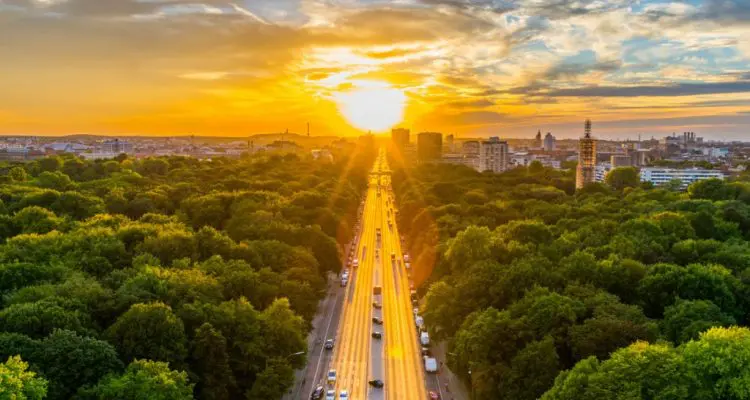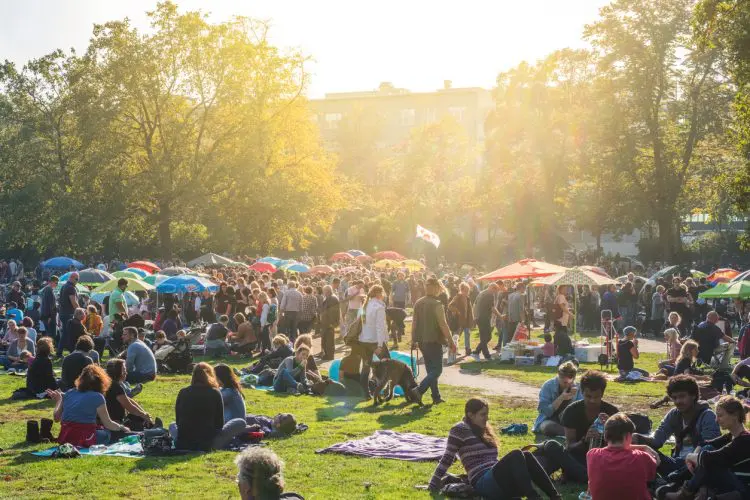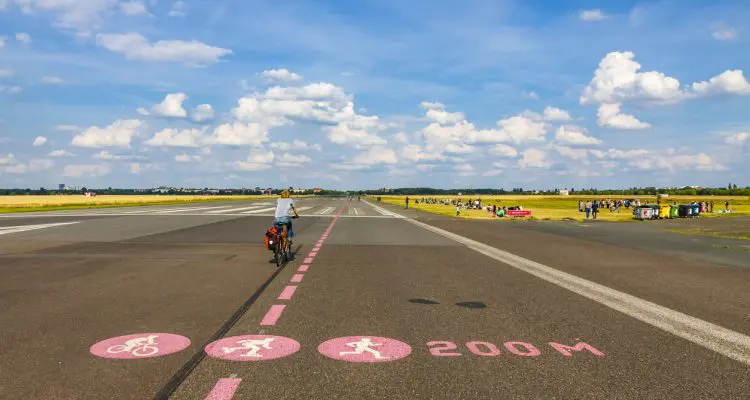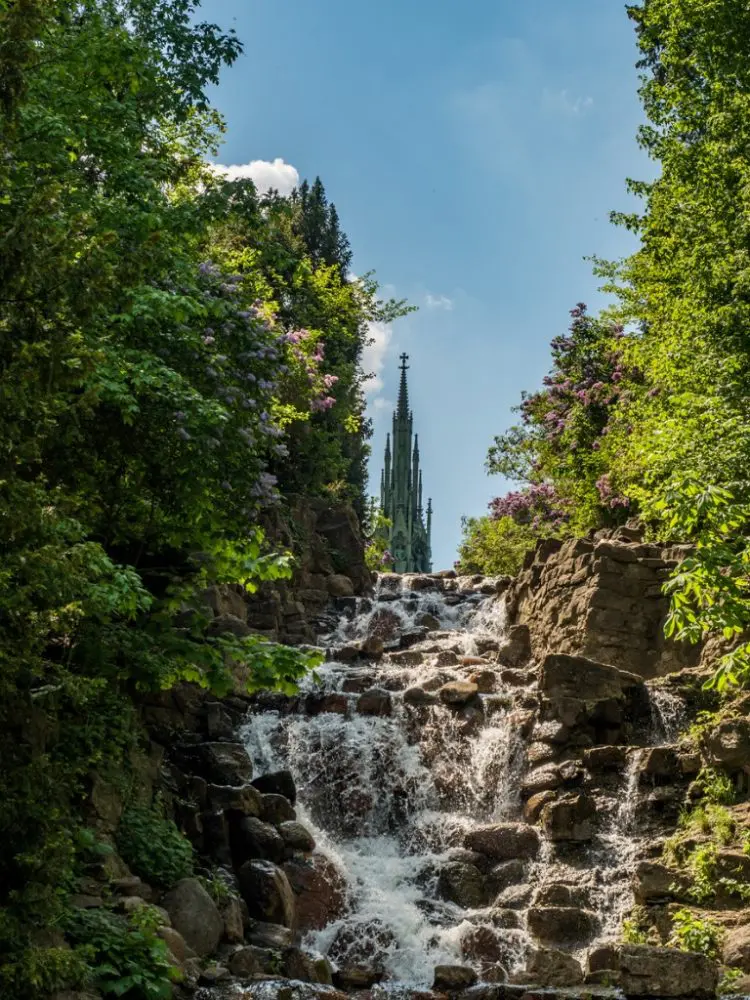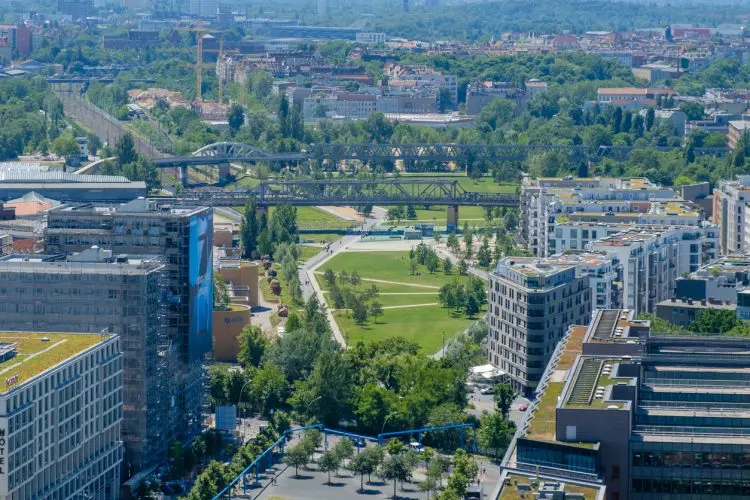With its history and design, you’re never more than a few blocks from green space in Berlin. The city contains forested areas and lakes large enough to hide the city, and is fully encompassed by a parkway, but its best parks all lie within its inner ring. No two locals have the same favorite park, as they run the gamut from hip Mauerpark, to charming Volkspark Friedrichshain. Park am Gleisdreickpark and Tempelhofer Feld attract picnickers and athletes alike, while Preussenpark is home to gourmands every weekend. From their ruins to their memorials, each of these parks makes the city’s history plain to see.
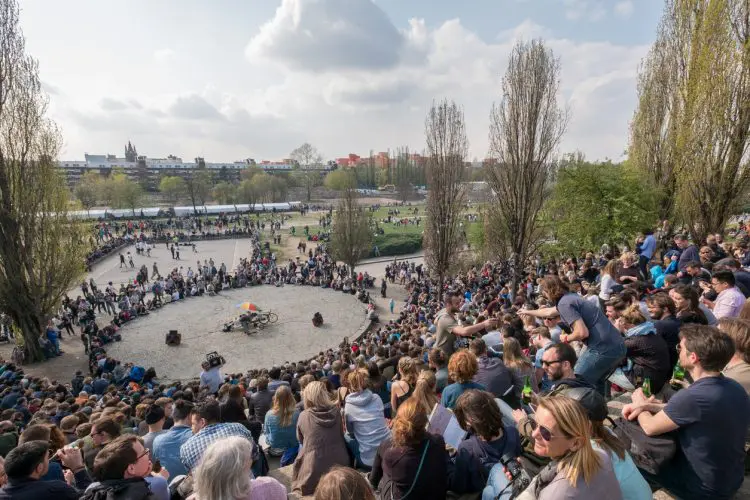
Jump to a section of this article
Mauerpark
Once covered by the Berlin Wall, Mauerpark (“Wall Park”) now hosts the city’s most popular flea market every Sunday. Located at the end of the Berlin Wall memorial strip, the market attracts some of the city’s most popular street food stands, while the park’s long grassy strip is home to a wide variety of buskers and picnicking locals. The park’s most unusual attraction is an amphitheater built into the side of a hill, famous for its karaoke sessions (starting at 3), with crowds of hundreds singing along (mostly in key).
Ten minutes down the street is the Kulturbrauerei (“Culture Brewery”), which hosts a quieter street food market every Sunday. An example of industrial architecture at its best, the courtyard of this massive former brewery is more upscale and attracts neighboring families. The compound includes an art cinema, galleries, theaters, restaurants, clubs, and museum devoted to everyday life in East Germany. In December, it hosts one of the city’s most popular Christmas markets.
Preussenpark
Every weekend, Preussenpark (“Prussian Park”) becomes the city’s most beloved food destination, known as Thaiwiese (“Thai Lawn”) or Thaipark. If you visit, you’ll find a park with dozens of women sitting on stools beneath umbrellas, preparing and selling food and drinks at low prices, as locals nap and chat between courses. This impromptu market takes place between the flea market above the Fehrbelliner Platz subway station, and the playground next to the Konstanzer Strasse subway station.
Treptower Park
Running along the Spree River, Treptower Park is popular with families out for a stroll, and the home port for many of the city’s tour boats. If you follow the river upstream, you’ll soon come to the Island of Youth, a small island connected by a beautiful bridge that arches across the river, with towers on either side. The island has an outdoor cafe and bar that hosts an open-air cinema in the summer. Further on lies a forest that hides the Spreepark, an abandoned amusement park. Even if you can’t catch one of the occasional tours of Spreepark, you can still peek through the fence of glimpses of its rides, dinosaur statues, and a Ferris wheel visible from far beyond the park.
The park’s main attraction is the largest of the city’s three Soviet war memorials. Built in the late 40s on the grounds of a mass grave for Soviet soldiers, the memorial grounds are a masterpiece of Stalinist architecture. After passing through large gates, kneeling statues, and red granite portals, visitors come to an area lined by trees and stone sarcophagi with carvings of quotes from Stalin, and reliefs of military scenes. The focus of the memorial is a 40-foot statue of a Soviet soldier holding a rescued German child on one hand, and a sword in the other. The soldier stands atop a crushed swastika, and the statue atop a hill overlooking the park and the city itself. While normally quiet, this park is the center of Victory Day celebrations held on May 9th by the local Russian community.
Volkspark Friedrichshain
The city’s third-largest park, the Friedrichshain People’s Park was a showcase for East Berlin. A stream with waterfalls popular with children leads to a lake next to a Peace Bell from Hiroshima. The park is home to other memorials, the largest of which commemorate volunteers who fought against fascism in Poland and Spain. Beneath the park’s two hills lie WWII flak towers and air-raid shelters. Too sturdy to be fully demolished after the war, they were instead covered by debris from nearby ruins. On hot days, families bring their children to the Märchenbrunnen, “Fairytale Fountains” that depict animals and characters from various legends.
Tempelhofer Feld
Built on former Knights Templar parade grounds, Tempelhof Airport was Europe’s second-oldest airport. After closing in 2008, it was resurrected as one of the city’s most popular parks. Tours are available of the terminal and hangers, which resemble an eagle with outstretched wings from the air, and which formed one of the world’s largest buildings upon their completion in the 1930s. Tempelhof was the center of the Berlin Airlift, as commemorated by an American DC-3 “Raisin Bomber.” The tarmac and runways provide ample room for any sports involving wheels, while grassy areas host many barbecues and picnics. One runway is devoted to wind sports, such as kiteboarding, while there is a community garden area and often a circus in summer, near a beer garden and a public pool. The airport also contains the world’s only field for “Boffer,” a sport involving foam weapons based on a post-apocalyptic cult film from the 80s.
Viktoriapark
Located on the edge of the Bergmannkiez neighborhood, which survived WWII largely intact, Viktoriapark is built around a steep hill. This elevation is crowned by a monument commemorating the Wars of (German) Liberation from Napoleon, which provides one of the city’s best views. From the memorial, an artificial waterfall runs to the base of the hill. The park is also home to the city’s last remaining vineyard, although Berlin’s homegrown wine is the subject of many jokes, and the park’s hobbyist vintners do not sell their wine.
Park am Gleisdreieck
Starting next to Potsdamer Platz, Gleisdreieck Park covers the grounds of what was once one of the city’s main rail yards, which served a railroad station that ended up on the other side of the Berlin Wall. The space feels cool and futuristic, with trains passing by overhead and emerging from a tunnel running to the main train station. Abandoned sections of track run between copses, playgrounds, volleyball courts, and gardens maintained by Balkan refugees who came to Berlin in the 90s. Dozens of disused railroad bridges cross a street that bisects the park, giving an idea of former rail yard’s size. Built on the grounds of a former train maintenance area, the German Museum of Technology, near the park’s center, is worth a visit. If you have a bike, we recommend following the park to its southern tip, then taking a new bike path along the active tracks past Südkreuz station to the Natur-Park Südgelände. This nature park encompasses another abandoned rail yard, but has kept its tracks intact. Südgelände also features tunnels, steam engines, and a roundhouse turned into an art venue.
What’s your favorite Berlin park?
If you’ve been to Berlin already which was your favorite? If you’re planning a trip to Central Europe that includes Berlin, your local JayWay destination expert will help you find yours.

Born and raised in Wisconsin, Kevin lived in Estonia and Finland for several years, traveling widely through Central and Eastern Europe, before settling down in Berlin. Having studied the cultures, histories, and economics of the countries along the Baltic Sea for his Master’s degree, Kevin has the knowledge and experience to help you plan the perfect trip anywhere in the region, and also works as JayWay’s main writer and editor.
